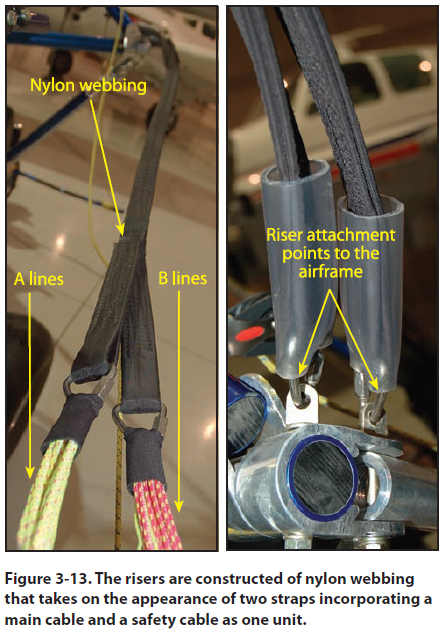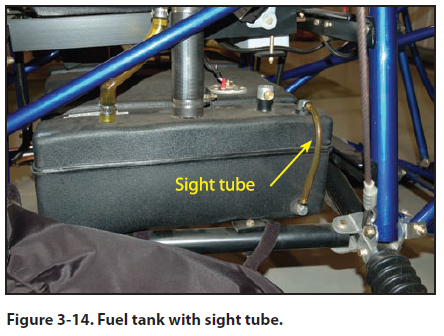|
Chapter 3 — Components and Systems
Risers
Also known as “V lines,” the risers are the intermediate
link between the suspension lines and the airframe
or the attachment point of the wing to the airframe.
The risers are generally constructed of webbing,
which takes on the appearance of two straps that incorporate
a main cable and a safety cable as one unit.
[Figure 3-13] Some of the older designs of wings may
have braided wire cables serving as their risers. The
risers are connected to the suspension lines and to the
aircraft with various connections such as with D-rings
and eyebolts.

During flight, as discussed in Chapter 2, propellerdriven
aircraft are affected by the rotation of engine
components and the propeller. This is commonly
referred to as the “left turning tendency,” which includes
torque and sometimes P factor. There are several
design features that have been incorporated into
airplanes to counteract the left turning tendency from
a clockwise turning propeller. Powered parachute designers
can counteract the turning effect by changing
the length of the riser cables on one side of the
airframe. By decreasing the length of the right riser
cable, the wing is given a slight right turn, just enough
to cancel the effects of torque at cruise thrust settings.
This design feature of the powered parachute wing
risers makes it imperative not to mistakenly attach the
different length riser cables on the wrong side of the
airframe. Remember: the left main and the left safety
cables, from the pilot’s seat, are longer than the right
main and the right safety cables. Mixing the right and
the left cables will result in a pronounced left turn;
especially during takeoff when the engine is at full
throttle, which could jeopardize the safety of all concerned.
Engine installations with a counterclockwise rotating
propeller require opposite adjustments. It is important
to know which direction the propeller turns for your
PPC to accurately counter turning tendencies.
Alternately, the wing could have the same length risers,
and the cart could have a higher attachment point
for the left riser. This is why each wing is designed
for each cart and should not be interchanged: the wing
and the cart is a complete system.
The Fuel Tank
The powered parachute is usually equipped with fuel
tanks ranging in capacity from 5 to 20 gallons. As
with any aircraft, knowing how much fuel your fuel
tank holds is crucial to flight operations. The lightsport
aircraft powered parachute has no limitations as
to the size of the fuel tank, unlike its ultralight vehicle
predecessor. Most PPC powerplants require auto fuel
mid-grade or higher to be burned (see the powerplant operating handbook for specific engine specifications).
Generally, the fuel tank is located close to the center
of gravity, so fuel burn does not affect the balance of
the aircraft. Some fuel tanks are clear for visual inspection
of the amount of fuel on board while others
are dark. Dark tanks or hidden tanks generally have a
sight tube to assist the pilot in determining the actual
amount of fuel. [Figure 3-14] Some powered parachute
manufacturers offer optional fuel level probes
and instrument panel analog gauges or incorporate
this information into the EIS. As fuel is used by the
engine, air needs to enter the tank and take its place;
otherwise a vacuum will form inside the fuel tank
preventing the fuel pump from drawing fuel. This is
usually accomplished with a fuel venting system. This
can be a vent in the fuel cap or some other means that
vents elsewhere, providing the ability for the fuel tank
to breathe. Any vent system must be free of debris or
it will cause fuel starvation in flight. This is especially
true when a small hole is in the fuel cap that can be
easily plugged. Check the fuel venting system during
each preflight inspection.

The fuel shut-off valve can be located anywhere in the
fuel line. It is important to make sure the fuel valve
is open and stays open for normal operation. Most
designs have a fuel tank sump drain valve to remove
water and solid contaminants. Each design is different
and the PPC POH will specify how to conduct
this check.
|

